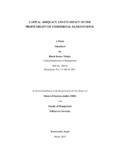Please use this identifier to cite or link to this item:
https://elibrary.tucl.edu.np/handle/123456789/1107| Title: | Capital Adequacy and its Impact on the Profitability of Commercial Banks In Nepal |
| Authors: | Thakur, Ritesh Kumar |
| Keywords: | Capital Adequacy;Return on Assets;Spread;Return on Equity |
| Issue Date: | 2019 |
| Publisher: | Central Departmental of Management |
| Abstract: | The primary functions of commercial banks are raise and utilization of funds. Commercial banks collect a large amount of deposit from general public. The bank should hold an adequate capital secure the interest of depositors.The aim of this study is to quantify the impact and simultaneously, the results is corroborating with the hypothesis that there is no significant impact of capital adequacy variables on the profitability of commercial banks in Nepal. Out of prevailing 28 commercial banks, secondary data of ten commercial banks from 2007 to 2016 were considered to analyze the factors that affect profitability. The descriptive statistics shows that, Nepalese commercial banks are earning satisfactory profit with average variation of return. The average CAR higher than regulatory requirement of 10%. It the evidence of the compliance of NRB directives and Basel III requirement. The AAR shows that aggressiveness of bank in lending funds which ultimately results in better profitability. The G-STIR ratio shows that the commercial bank are investing in risk free assets, they are risk averter.NPLR shows low return and high risk in Non-performing loan. The correlation coefficient shows the positive and negative impact of the dependent and independent variables. The correlation coefficient between CAR, D-ER and NPLR which shows that there is negative correlation with ROA. It means higher capital leads to lower ROA, ROE and Spread. The correlation coefficient between CAR, D-ER and NPLR is negative related with spread. It shows that higher the CAR, D-ER, NPLR the lower will be the profit of the commercial banks in Nepal. The correlation coefficient between G-STIR and AAR is positive. The regression analysis shows relationship with independent and dependent variables both. There is significantly negative relationship between ROA, ROE and Spread with CAR, D-ER, AAR and NPLR. Regression analysis shows positively insignificant relationship between government securities to total investment at significant level 0.005 with ROA, ROE and Spread. KEYWORDS: Capital Adequacy, Return on Assets, Spread, Return on Equity. |
| URI: | http://elibrary.tucl.edu.np/handle/123456789/1107 |
| Appears in Collections: | Finance |
Files in This Item:
| File | Description | Size | Format | |
|---|---|---|---|---|
| Ritesh Kumar Thakur.pdf | 830.95 kB | Adobe PDF |  View/Open |
Items in DSpace are protected by copyright, with all rights reserved, unless otherwise indicated.
